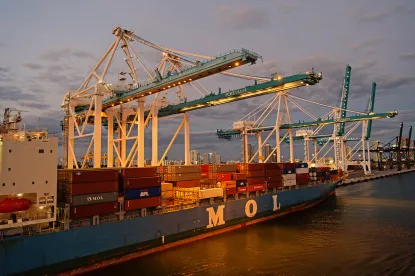In Jackson v. Chem Carriers, LLC, the Louisiana First Circuit Court of Appeal reversed the trial court’s judgment and held (1) that a renovated barge was not a vessel in navigation and (2) that the plaintiff did not qualify as a seaman because, in pertinent part, his work duties did not take him to sea or involve seagoing activity.[1] The decision followed the US Court of Appeals for the Fifth Circuit’s recent decision of Sanchez v. Smart Fabricators of Texas, LLC, 997 F.3d 564 (5th Cir. 2021),[2] in which the federal appellate court pronounced a refined test for seaman status. Jackson is the first Louisiana appellate court to render a decision post-Sanchez, and the case will serve as an invaluable guide to Louisiana trial courts when determining the status of maritime workers.
The plaintiff in Jackson worked as a welding foreman for Plaquemine Point Shipyard, LLC (PPS). PPS owns and operates a floating ship repair and cleaning facility attached to the east bank of the Mississippi River. The cleaning plant prepares cargo barges for load preparation, while the repair facility repairs barges as needed for PPS’s customers. The floating repair facility consisted of several barges, a dry dock, and a shop barge. Pertinent to this case, the repair facility included the TT-24602 barge (TT barge), which was a platform running perpendicular to the bank and connected thereto with a welded ramp, utility lines, and two shore wires. In addition, the PPS-10 barge was secured perpendicular to the TT barge with two winch cables and utility connections. In short, the majority of the equipment was connected to and/or tied off to the bank and primarily used as work platforms. With respect to the plaintiff, in addition to his welding duties, he trained other welders, would occasionally go out onto the barges at the facility to test tanks, and would sometimes assist with tying off incoming barges. The plaintiff did not live at the shipyard or on any boat in the shipyard. He drove to the shipyard every day in his own vehicle and left every night. The appellate court specifically noted that he did not have a Transportation Worker Identification Card (TWIC).
On October 20, 2016, while traversing the PPS-10 barge to check on a welding machine, the plaintiff tripped over a welding cable, fell, and suffered injuries to his right shoulder. He subsequently filed suit against, inter alia, PPS.[3] Specifically, the plaintiff alleged that he was a member of the crew of the vessels owned and operated by the defendant (a.k.a. the floating shipyard), and he brought claims under the Jones Act and the General Maritime Law. In the alternative, he brought claims pursuant to the Longshore and Harbor Workers’ Compensation Act (LHWCA).
Following a five-day bench trial, the trial court found that the PPS-10 as well as other equipment were all vessels in navigation owned and controlled as part of an identifiable fleet. Likewise, finding the PPS-10 to be a vessel, the trial court held that the plaintiff spent well over 30% of his time on these vessels and that he was “subject to the perils of the sea.” Accordingly, the trial court entered judgment against PPS. PPS subsequently appealed, contending that the trial court erred in finding the PPS-10 was a vessel and that the plaintiff was a Jones Act seaman.
In analyzing the issues on appeal, the Louisiana First Circuit began with the vessel status issue. Citing Lozman v. City of Riviera Beach, 568 U.S. 115 (2013), as well as other precedent, the First Circuit explained that “a structure is not a vessel unless a reasonable observer, looking to its physical characteristics and activities, would consider it designed to a practical degree for carrying people or things over water.” (emphasis added).Reviewing the evidence, the First Circuit observed that although the PPS-10 was originally constructed as a railroad barge designed to haul rail cars, it had been physically altered and was now secured to the TT barge with wires and used as a work platform. It had no means of self-propulsion, had no American Bureau of Shipping certificates, and did not have a Coast Guard certificate of inspection. Moreover, although the PPS-10 was capable of movement and had been moved within the facility, the barge was moved only occasionally and only to reposition itself for repair work — it never traveled anywhere else for repairs. Accordingly, focusing on the PPS-10’s activities, the Louisiana First Circuit held that the trial court committed error in finding it to be a vessel in navigation.
Having found the PPS-10 was not a vessel in navigation, the Louisiana First Circuit then turned to the issue of seaman status. On appeal, PPS contended that the plaintiff was not a seaman because he was employed as a welder in a shipyard, he was not a member of a vessel crew, and his assignments to vessels were random and impermanent with no allegiance thereto. Likewise, PPS argued that there existed no evidence that the plaintiff spent 30% of his time on the equipment identified as “the fleet.”
To resolve the issue of seaman status, the Louisiana First Circuit began its analysis by noting that although the term “seaman” is not defined in the Jones Act, “Congress intended the term to have its established meaning under the general maritime law at the time the Jones Act was enacted.”[4] Accordingly, the court looked to federal precedent for guidance. In a trilogy of cases, the US Supreme Court established a two-prong test for seaman status: (1) whether the employee’s duties “contribute to the function of the vessel or to the accomplishment of its mission” and (2) whether the employee has “a connection to a vessel in navigation (or to an identifiable group of such vessels) that is substantial in terms of both its duration and nature.”[5] Specifically, however, in Papai, the US Supreme Court clarified that “[f]or the substantial connection requirement to serve its purpose, the inquiry into the nature of the employee’s connection to the vessel must concentrate on whether the employee’s duties take him to sea.”[6] Relying on this Papai principle, in Sanchez, the US Court of Appeals for the Fifth Circuit expanded upon the “nature” requirement of seaman status and held that courts should make the following additional inquiries:
-
Does the worker owe his allegiance to the vessel rather than simply to a shoreside employer?
-
Is the work sea-based or involve seagoing activity?
-
(a) Is the worker’s assignment to a vessel limited to performance of a discrete task after which the worker’s connection to the vessel ends, or (b) does the worker’s assignment include sailing with the vessel from port to port or location to location?
For that reason, relying on both Papai and Sanchez, the Louisiana First Circuit initially focused on the “nature” prong of the substantial connection requirement.
In terms of allegiance to a shoreside employer or to a vessel, the Louisiana First Circuit held that because PPS owned the other vessels the plaintiff regularly worked on, the evidence and testimony established that the plaintiff owed his allegiance to both the vessels on which he worked as well as PPS, his shoreside employer.
As for sea-based or seagoing activity, the Louisiana First Circuit noted that although the test does not require the worker to literally “go to sea,” the worker should be involved in some transportation activity. Considering the facts and evidence, the Louisiana First Circuit found that the plaintiff’s welding work was not of a “seagoing nature.” Specifically, the plaintiff would work on various boats and barges that came into the shipyard for repair and he did not travel outside of the facility for this work. Moreover, there was no evidence that the plaintiff performed his welding work while any vessel performed transportation activities; rather, all the vessels on which he worked remained stationary in the shipyard. In sum, citing Papai and Sanchez, the Louisiana First Circuit found that the plaintiff’s work could not be considered sea-based or its nature seagoing activity.
As for the third inquiry, the Louisiana First Circuit held that the plaintiff’s work on PPS’s floating equipment did not consist of discrete tasks, as he assisted them in their respective repair missions. Notwithstanding the foregoing, it was clear that the plaintiff never “sailed” on any of PPS’s barges; rather, he only traveled two to three times to weld, and he rode on boats not owned by PPS. Furthermore, as for facing “perils of the sea,” the Louisiana First Circuit explained that while the plaintiff worked on water and of course was subject to certain marine risks, it was clear that because the plaintiff’s work was not seagoing and he did not sail with any vessels, he did not face the traditional “perils of the sea” contemplated by the Jones Act.
Accordingly, considering the Sanchez inquiries, the Louisiana First Circuit held that the plaintiff-welder did not establish a substantial connection to a vessel in terms of the nature of his work. With respect to the “duration” prong, having found the PPS-10 was not a vessel, the First Circuit held that the plaintiff failed to set forth sufficient evidence on this prong. Likewise, the court noted that the time the plaintiff spent on vessels not owned by PPS could not be considered for purposes of establishing the substantial duration prong, as those vessels were not under common ownership of PPS.
In sum, considering the facts and evidence and relying on Sanchez, the Louisiana First Circuit held that the plaintiff was not a Jones Act seaman and, thus, PPS was not liable under the Jones Act. Therefore, the court reversed the trial court’s ruling and remanded for further proceedings.
This case has implications for classifying maritime workers, which in turn can affect contractual obligations, insurance issues, and determine the causes of action available as well as the scope of recoverable damages for the injured worker.
FOOTNOTES
[1] 2022-0043 (La. App. 1 Cir. 11/04/22); 2022 La. App. LEXIS 1912.
[2] 5th Circuit Unanimously Announces New Test for Jones Act Seaman Status
[3] The plaintiff alleged that PPS and Chem Carriers, LLC/Chem Carriers Towing, LLC, owned the facility and the “vessels” at issue and claimed these entities operated as a single business enterprise. The trial court held that the single business enterprise theory was not applicable and dismissed the plaintiff’s claims against Chem Carriers.
[4] Chandris, Inc. v. Latsis, 515 U.S. 347, 355 (1995).
[5] McDermott Int’l, Inc. v. Wilander, 498 U.S. 337 (1991); Chandris, 515 U.S. at 376; Harbor Tug & Barge Co. v. Papai, 520 U.S. 548, 555 (1997).
[6] Papai, 520 U.S. at 555.




 />i
/>i
